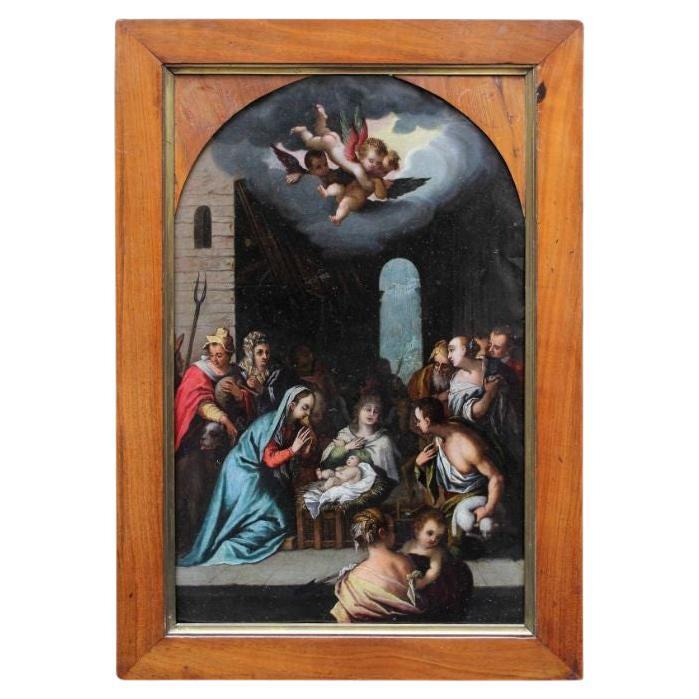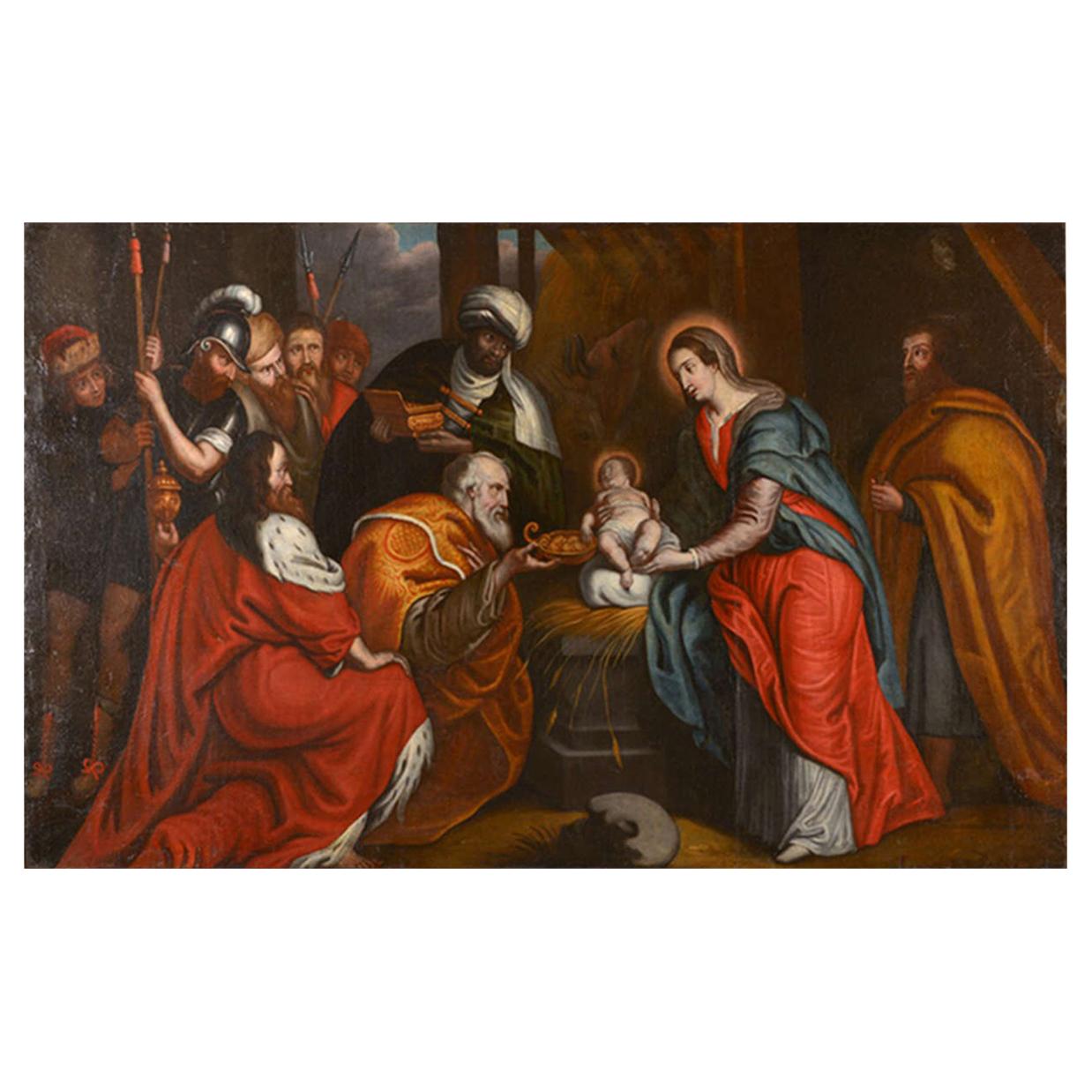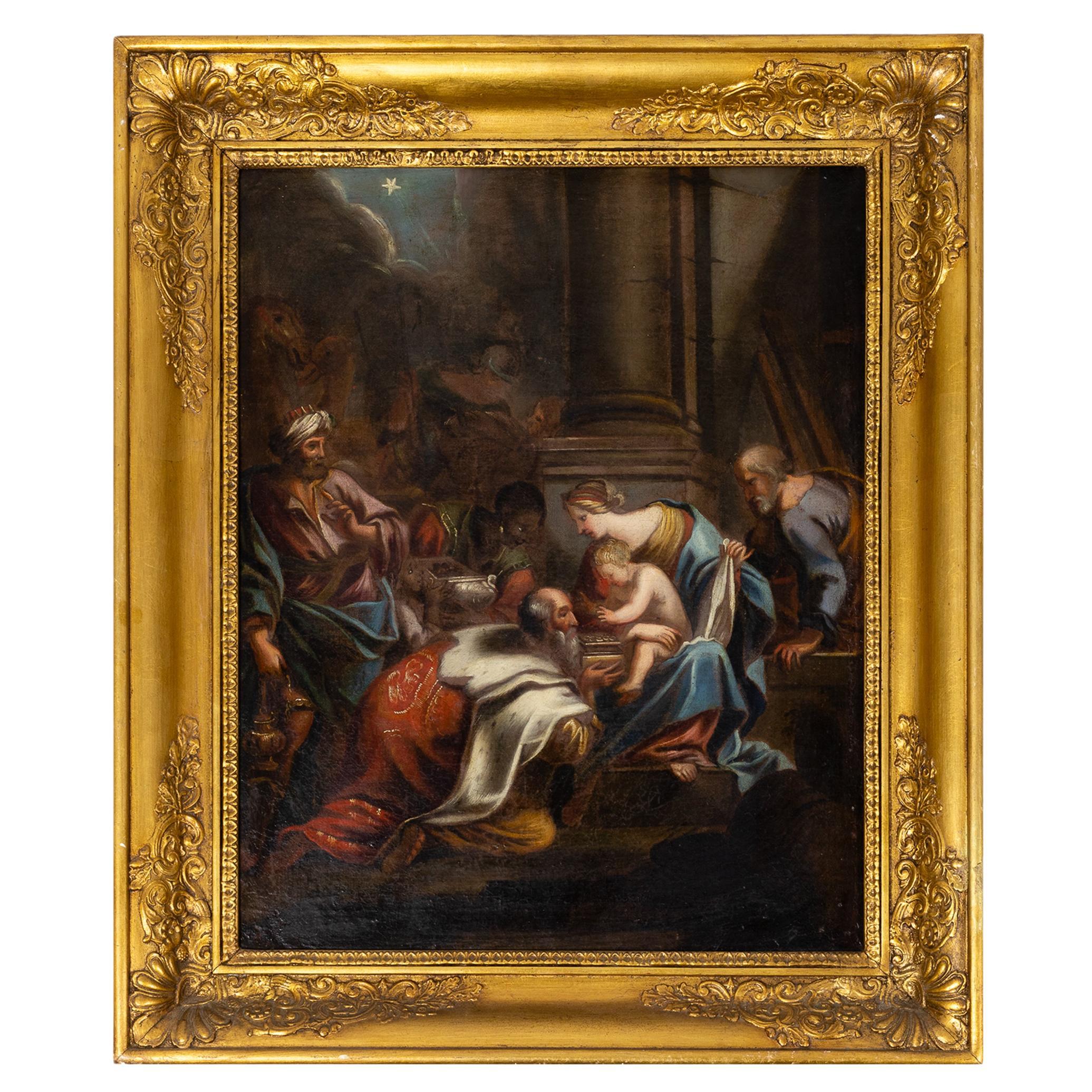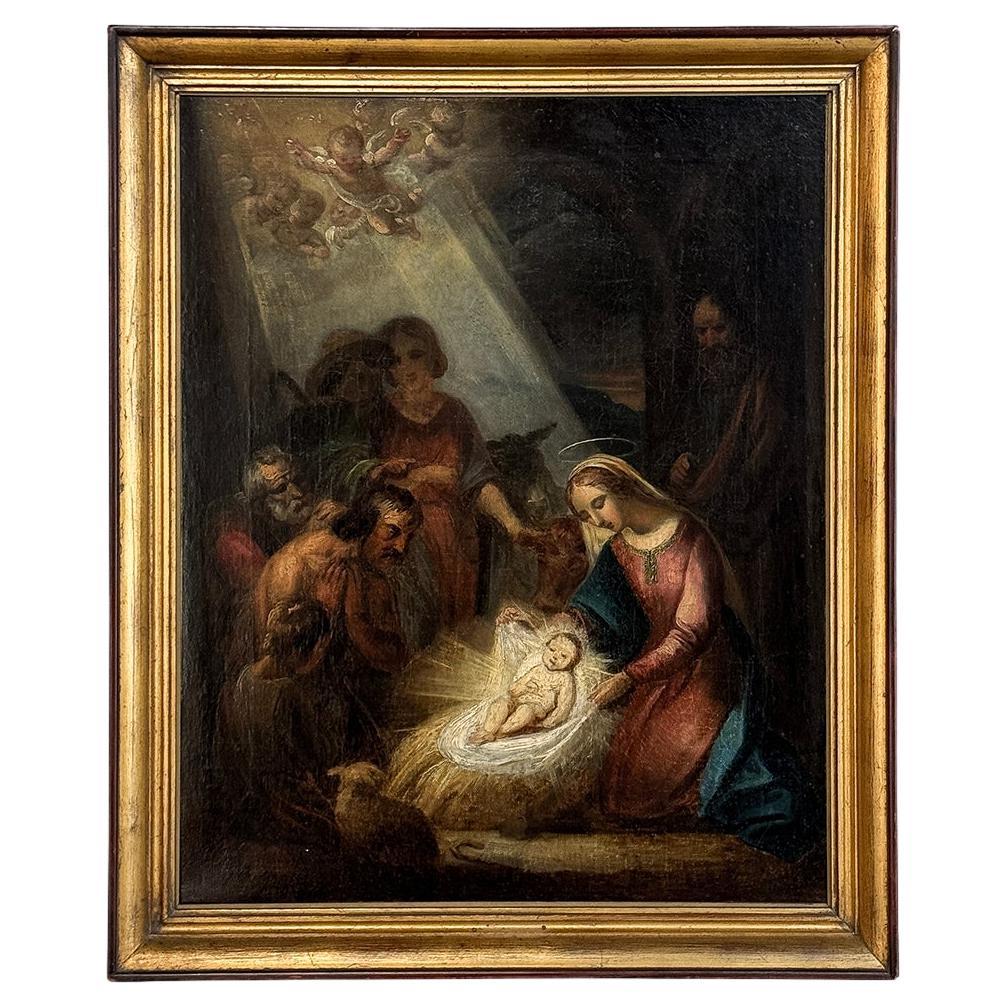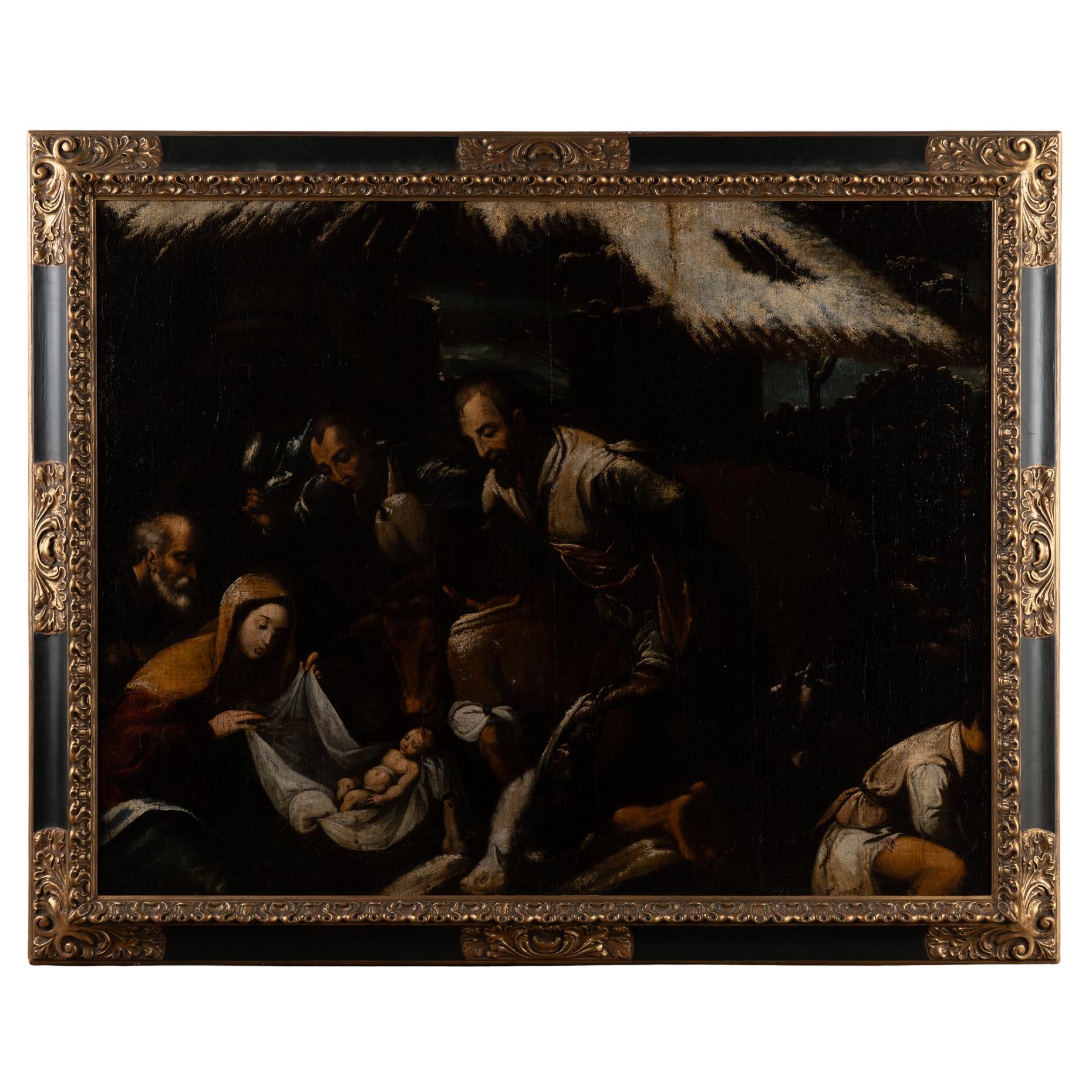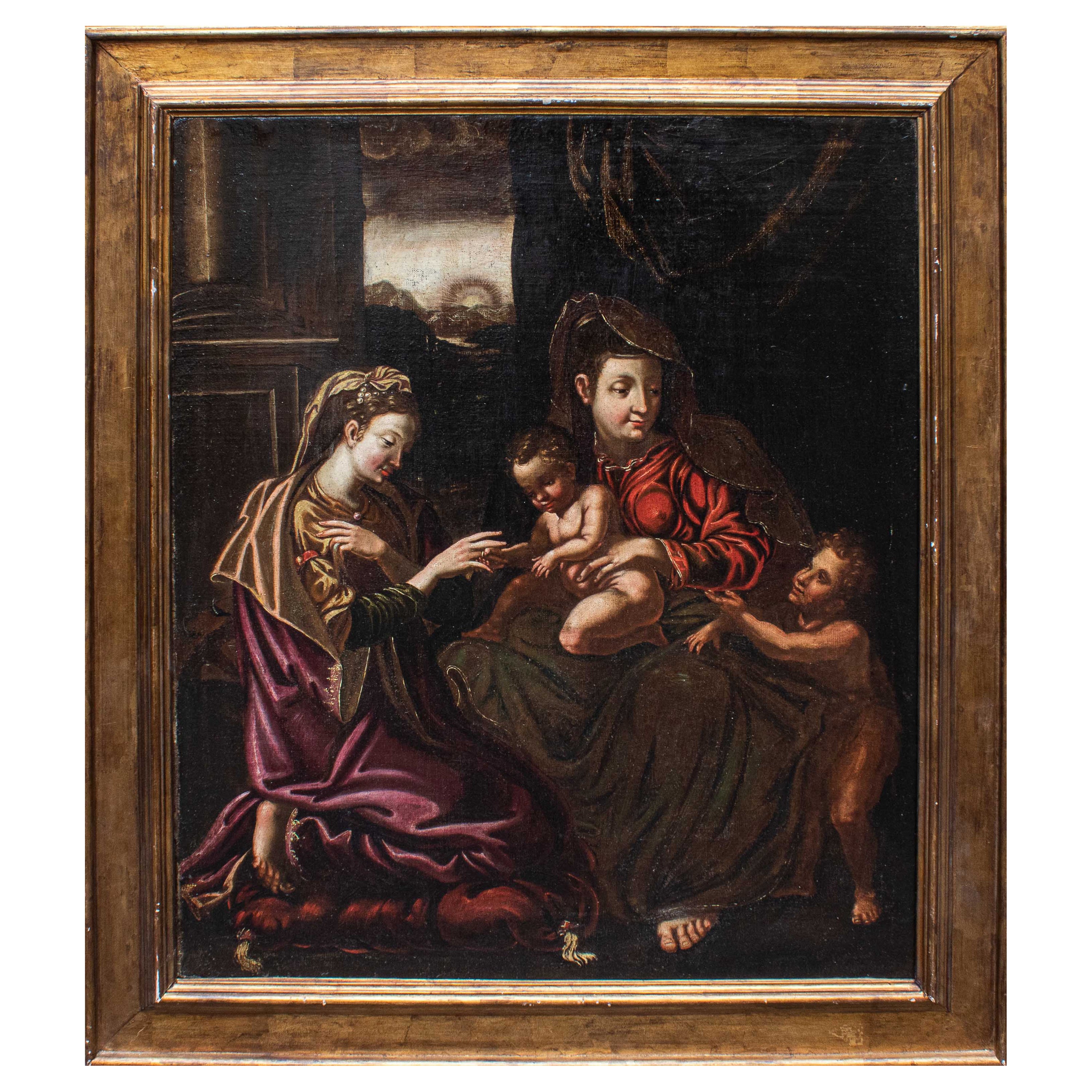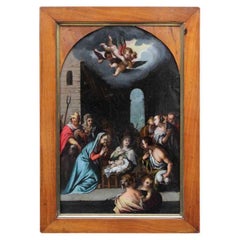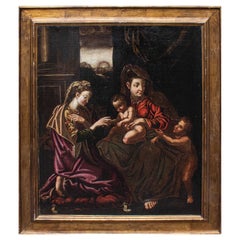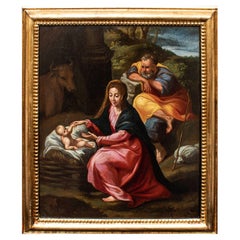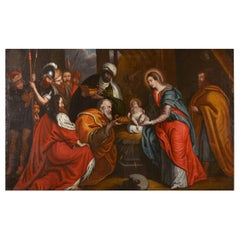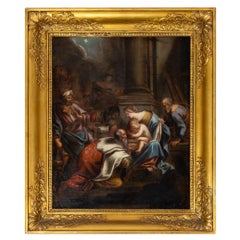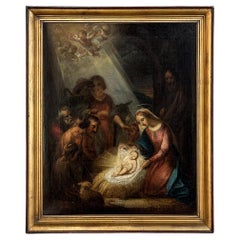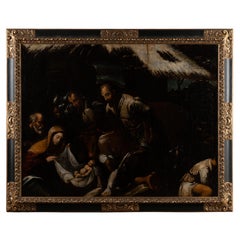Items Similar to 16th Century Adoration of The Shepherds Painting Oil on Copper
Want more images or videos?
Request additional images or videos from the seller
1 of 19
16th Century Adoration of The Shepherds Painting Oil on Copper
$4,556.88per set
£3,389.86per set
€3,800per set
CA$6,239.93per set
A$6,937.95per set
CHF 3,622.61per set
MX$84,451.74per set
NOK 46,222.98per set
SEK 43,308.73per set
DKK 28,927.30per set
Shipping
Retrieving quote...The 1stDibs Promise:
Authenticity Guarantee,
Money-Back Guarantee,
24-Hour Cancellation
About the Item
Attr. to Girolamo Siciolante known as da Sermoneta (Sermoneta, 1521 - Rome, 1575)
Adoration of the Shepherds
Oil on copper, 39 x 29.5 cm
Frame 47 x 39 cm
The refined taste, the refined poses, the definition of the anatomies, the vibrant light, allow us to identify for this painting the hand of a Mannerist painter active during the sixteenth century. In particular, the composition and stylistic research allow us to attribute the panel to Girolamo Siciolante, known as da Sermoneta (1521 - 1575). His first training took place under the guidance of Leonardo Grazia known as da Pistoia (1502 - 1548). Later he settled in Rome where he was able to see the painting of Raphael and Michelangelo from life and where he was first a pupil and then a collaborator of Perin del Vaga (1501 - 1547). He settled in Rome where he received numerous commissions and participated in the decoration of numerous churches, such as the church of S. Maria dell'Anima, where there is a cycle with Stories of the Virgin, including a Nativity of the Virgin, a Presentation of the Virgin and a Visitation which have stylistic and formal consonances with the copper analyzed here. Another interesting stylistic comparison is identified with a fresco in the Vatican Palaces, depicting Pepin, king of the Franks, donating the territory of Astolfo king of the Lombards to the Church.
Around 1545, he made a trip to Emilia, where he met the works of Garofalo (1476 - 1559) and Bagnacavallo (1484 -1542). This experience opened his culture to also Emilian influences, with a classicist taste. The particular use of the light of this copper gives a charm and a rare quality to the composition: the light turns on and gives a mystical charm to the main figures, the center of the work and in the same way, in a more light and suffused way, it lights up the other figures. and the background, which fades into a broad architectural perspective.
The adoration of the shepherds is an event in the life of Jesus described in the Gospel of Luke (2: 8-20): at the moment of his birth in Bethlehem some shepherds are warned of the event by an angel and go to adore the newborn. Luke's Gospel is the only one of the canonical Gospels to narrate the episode. While some shepherds watched outdoors watching over the flock, an angel appears to them and they are frightened. The angel calms them and tells them that a Savior, Jesus, was born in Bethlehem; He also gives him a sign that in Bethlehem they would find a baby wrapped in swaddling clothes and lying in a manger. Immediately afterwards a group of angels appears, chanting the words "Glory to God in the highest and peace on earth to the men he loves". After the angels are gone,
The back of the copper is embellished with a representation of St. Joseph with the Child.
- Dimensions:Height: 18.51 in (47 cm)Width: 15.36 in (39 cm)Depth: 1.58 in (4 cm)
- Sold As:Set of 2
- Materials and Techniques:
- Place of Origin:
- Period:
- Date of Manufacture:16th Century
- Condition:Refinished. Wear consistent with age and use. The painting has been cleaned.
- Seller Location:Milan, IT
- Reference Number:1stDibs: LU5918226733702
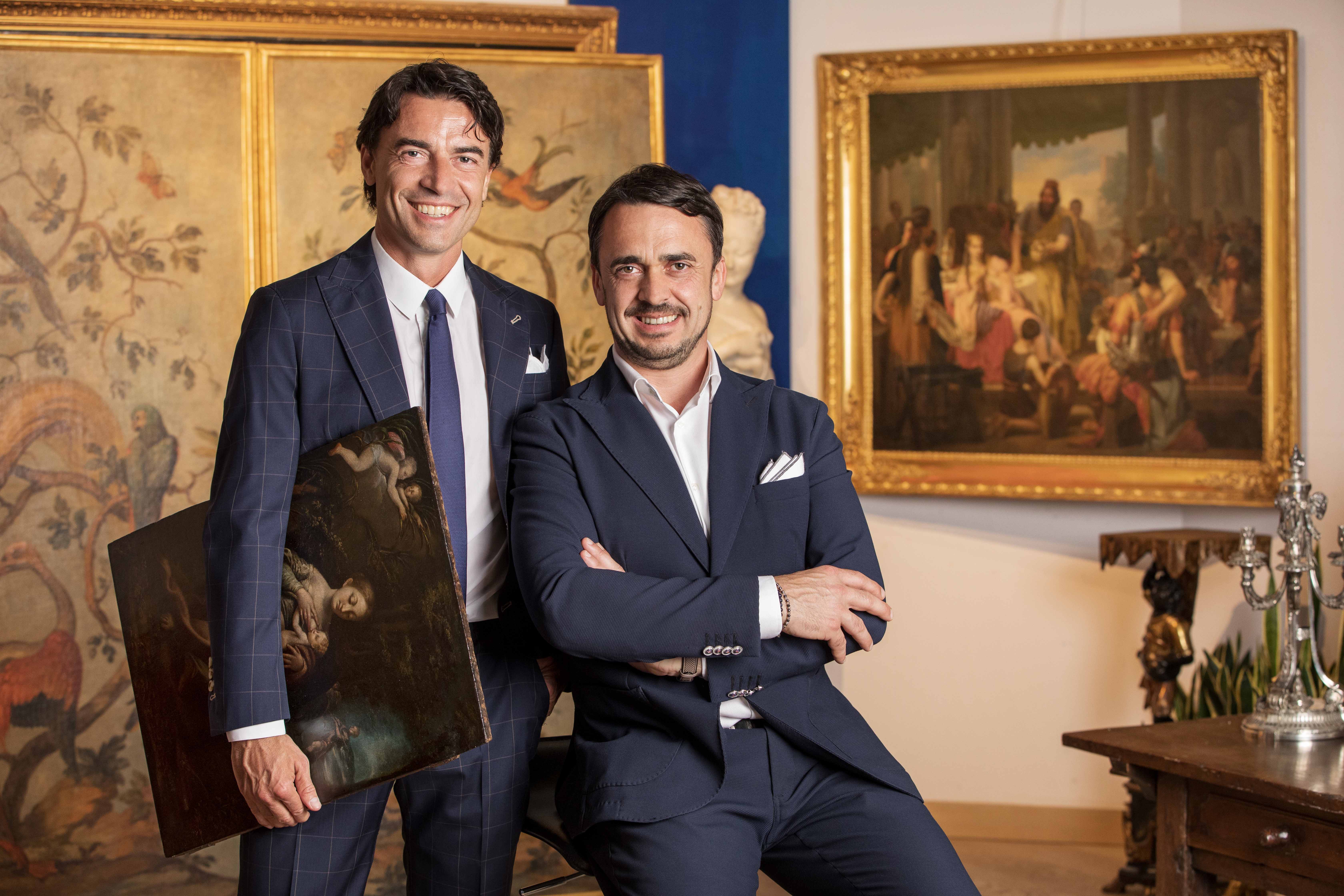
About the Seller
5.0
Vetted Professional Seller
Every seller passes strict standards for authenticity and reliability
Established in 2000
1stDibs seller since 2021
30 sales on 1stDibs
- ShippingRetrieving quote...Shipping from: Milan, Italy
- Return Policy
Authenticity Guarantee
In the unlikely event there’s an issue with an item’s authenticity, contact us within 1 year for a full refund. DetailsMoney-Back Guarantee
If your item is not as described, is damaged in transit, or does not arrive, contact us within 7 days for a full refund. Details24-Hour Cancellation
You have a 24-hour grace period in which to reconsider your purchase, with no questions asked.Vetted Professional Sellers
Our world-class sellers must adhere to strict standards for service and quality, maintaining the integrity of our listings.Price-Match Guarantee
If you find that a seller listed the same item for a lower price elsewhere, we’ll match it.Trusted Global Delivery
Our best-in-class carrier network provides specialized shipping options worldwide, including custom delivery.More From This Seller
View All16th Century Adoration of the Shepherds Painting Oil on Copper by Carnevale
By Carnevale Studio
Located in Milan, IT
Domenico Carnevale (Sassuolo, 1524 - Modena, 1579) Adoration of the Shepherds
Oil on copper, 42 x 28 cm
Frame 54 x 36 cm
Expert opinion of Prof. Emilio Negro
The painting represents the Adoration of the Shepherds, the Child in the center, next to the Madonna kneeling in prayer and an angel behind her; towards him in the foreground a woman with a child in her arms, a shepherd with a sheep on the right, a bagpiper on the left and various other male and female characters turn to him. The architectures of the background, between which a glimpse of the landscape can be glimpsed, are hidden in the upper part by the clouds, where a "celestial glory" encamps with three flying angels.
The painting shows mannerist characters that can be traced back to the second half of the sixteenth century, and can be traced back to an author from the Modena area, with stylistic references to the Bolognese Samacchini (1532 - 1577) and Passerotti (1529 - 1592). More precisely, it can be attributed to Domenico Carnevale (1524-1579), one of the most important masters of the sixteenth century active in the local area. The Carnival was formed in Emilia, his homeland, where he worked for many years. However, his works also show a clear Roman influence, dictated by a long experience in the city, during which he also dedicated himself to the restoration of the Sistine Chapel. Trained in the late-mannerist environment of Modena, he is also linked to the Parmesan Corrorese and Ferrarese Dossesque tradition; Carnival also always maintains a slight archaic sentiment in his work,
The main stylistic reference must be identified in a work similar in subject and iconographic setting, coming from the church of the Pio Istituto Orfanelle di San Geminiano di Modena, currently part of the Art Collection of the Province, attributed to the same influence as the Carnival. Another interesting comparison should be identified with A Presentation of Jesus in the Temple...
Category
Antique 16th Century Italian Paintings
Materials
Copper
17th Century Mystical Marriage of Saint Catherine Painting Oil on Canvas
Located in Milan, IT
17th century
Mystical marriage of Saint Catherine
Measures: Oil on canvas, 98 x 81 cm - with frame 119 x 102 cm
The scene represents the mystical marriage between Catherine of A...
Category
Antique 17th Century Italian Paintings
Materials
Canvas
17th Century Rest on The Flight to Egypt Emilian school Painting Oil on Canvas
Located in Milan, IT
17th century, Emilian school
Rest on the flight to Egypt
Oil on canvas, 42 x 33 cm
Frame 65 x 55 cm
The present Holy Family, ...
Category
Antique 17th Century Italian Paintings
Materials
Canvas
17th Century Rest on the flight to Egypt Emilian School Painting Oil on panel
By Parmigianino
Located in Milan, IT
17th century, Emilian school, Pamigianino painter
Rest on the flight to Egypt
Oil on panel, 46 x 39 cm - with frame 55.5 x 48.5 cm
The wor...
Category
Antique 17th Century Italian Paintings
Materials
Wood
17th Century Mystical Marriage of Saint Catherine Oli on Canvas Roman School
Located in Milan, IT
17th century, Roman School
Mystical marriage of Saint Catherine of Alexandria
Oil on canvas, 32 x 23 cm
Frame cm 45 x 36
The saint is depicted in front of the Virgin holding the Child portrayed with the wedding ring in his hand, enriched with a precious stone. According to the Golden Legend, Catherine of Alexandria was a very beautiful young woman, the only daughter of the king of Costa, who had refused to marry the emperor Maxentius because she was a Christian and devoted to Christ. Maxentius, unable to convince her to sacrifice to idols, had sent to call the wisest men and fifty philosophers and orators who presented themselves and tried to divert her from faith in Christ. Catherine, however, played so well that she was able to convert them, arousing the anger of the emperor who condemned them to the stake. Catherine, however, who had criticized Maxentius for the new persecutions against the Christians, was sentenced to prison without food. Abandoned for twelve days, she was fed by a dove sent by God. Maxentius then decided to execute her with the torture of the toothed wheel become her attribute iconographic; but by divine intervention this broke and the young was saved. Finally, she was beheaded and milk flowed from her neck. Catherine’s princely status is witnessed here by her sumptuous dress. The iconography of the mystical marriage was born in the fifteenth century, probably because the traditional iconographic attribute, the wheel, was sometimes so small as to look like a ring, and refers to a vision that will always remain present in the mind and heart of the saint. In Heaven she appeared to her, among the Angels and Saints, Christ the Child, in the arms of the Virgin. He took a precious ring that the Virgin Mary handed to her and put it in her finger, saying "I, your Creator and Saviour, take you in marriage; confident that you will keep you pure until you celebrate your eternal wedding with me, in Paradise" When Catherine was laughing, she found in her finger the same ring that she had seen and had in Heaven, and she considered herself forever the bride of Christ.
In this extraordinary episode we can see the heart of Catherine’s religious sense, and of all her spirituality. For her, Christ is like the bridegroom, with whom there is a relationship of intimacy, communion and fidelity; he is the beloved, whom she loves above all...
Category
Antique 17th Century Italian Decorative Art
Materials
Canvas
17th century, Flemish School, Adoration of the Magi
Located in Milan, IT
17th century, Flemish School
Adoration of the Magi
Oil on copper, diam. 19.5 cm
Framed 35.3 x 35.3 cm
Engraved on the back in seventeenth-century calligraphy "Fiamingo"
Vivid wo...
Category
Antique 18th Century and Earlier Dutch Other Paintings
Materials
Copper
You May Also Like
Flemish 17th Century Oil on Canvas Painting of the Adoration of the Magi
Located in Houston, TX
Beautiful Flemish 17th century oil on canvas painting depicting the adoration of the magi. Vivid color and wonderful quality of pa...
Category
Antique 17th Century Dutch Paintings
Materials
Canvas
Adoration of the Magi Paiting, Italian Baroque Religious Art, 18th Century
Located in Lisbon, PT
This 18th century Italian painting captures one of the most iconic biblical moments: the Adoration of the Magi.
The mysterious travelers kneel in reverence before the Infant Jesus, ...
Category
Antique 18th Century Italian Baroque Paintings
Materials
Canvas
$9,485 Sale Price
20% Off
18th Century Framed Oil Painting on Canvas of Nativity ~ Flemish School
Located in Dallas, TX
18th Century Framed Oil Painting on Canvas of Nativity ~ Flemish School is an amazingly inspirational work, displaying the influences of the Old Masters in the setting, composition, ...
Category
Antique Late 18th Century Dutch Aesthetic Movement Paintings
Materials
Canvas, Giltwood
17th Century Original Oil on Canvas Painting of The Adoration of the Magi, Spain
Located in Round Top, TX
Original oil on canvas painting of the adoration of the magi, with Mother Mary and infant Christ.
Framed over 5' wide x 4' tall, no signature/unknown artist.
Canvas has craquelure, o...
Category
Antique Early 17th Century Spanish Paintings
Materials
Canvas, Wood, Paint
Antique Nativity Italian Painting
Located in Alessandria, Piemonte
Antique Nativity Christmas Italian oil painting on canvas, from first half 17th century. Anonymous painter (as usual at that time) and with an authe...
Category
Antique Early 17th Century Italian Archaistic Paintings
Materials
Canvas
Flemish School Painting, Adoration of the Child, 18th Century, Religious art
Located in Lisbon, PT
This 18th-century Flemish oil on wood painting depicts the moment of adoration of the Child Jesus, in the loving arms of the Virgin Mary.
Kneeling at their feet is the young Saint J...
Category
Antique 18th Century Dutch Baroque Paintings
Materials
Wood
$6,933 Sale Price
20% Off
More Ways To Browse
Jesus And Joseph
Antique Italian Nativity
Adoration Of The Shepherds
Adoration Shepherds
Italian Nativity Figures
Steve Burgess
Szasz Paintings
Thomas Pulgini
Turner Airbrush
Used Furniture North Shore Ma
Victor Petre
Vintage Magnolia Mirror
Vintage Vanguard Lee Reynolds
Weinstein Gallery
Wyatt Earp
Xavier Wurth
A Rangel Hidalgo Painting
Adolf Menzel
